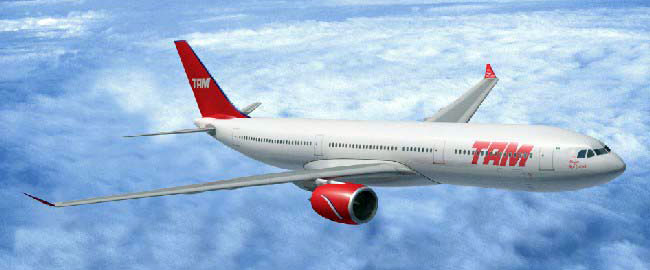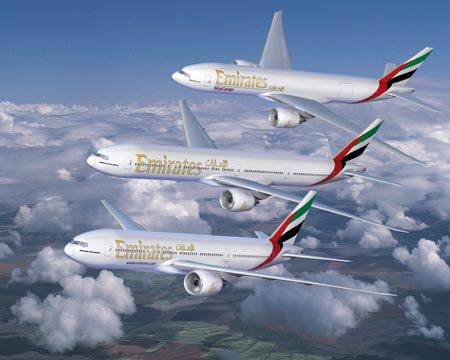

 |
 |
|
| |
||
Air
Cargo Outlook 2006 The
Chinese Market India's Booming Market India aviation growth with liberalization as driving force has been more than encouraging with air transport up 7% per annum as against the plan estimate of 5%. During 2004-05, air transport soared up 24% causing the government to revise estimates even further upward. Now India thinks an average growth rate of 16% p.a. is achievable by 2010. India is the fourth largest economy in the world in terms of purchasing power parity with its 300 million strong middle class. Many feel that if the present growth trend can be sustained, civil aviation will be a driving force for the "take off" of the Indian economy. Entrepreneurs, bankers, financiers and investors worldwide are now convinced about the healthy growth prospects for Civil Aviation in India. Therefore, it is not surprising that a number of new airlines have entered the market while existing airlines are going for significant fleet expansion/renewal. Five new carriers including viz, Air Deccan, Kingfisher, Spice Jet, Paramount Airways and Go Airlines have started operations, with other readying in the wings. There has also been a significant increase in both domestic and international air traffic as well as cargo in India during the year 2005. Limited Open Sky Policy launched last year has permitted designated foreign carriers to mount as many services as they wish, subject to the terms and conditions of the existing commercial arrangements. Also foreign airlines have been permitted to upgrade their equipment at their existing frequencies. Europe "Go East" In Europe it is not "Go West" anymore – it’s “Go East.” Ten new members of the European Union are ambitiously pushing their economies ahead. There are a number of refreshing, not necessarily big airlines in Poland, Hungary, Ukraine, Slovakia and elsewhere beginning to spread their wings to Western Europe and beyond. As 2005 ended, Air France and KLM took the necessary steps to slowly meld the different national and corporate cultures together, to be recognized as one brand with two names. But give ’em credit as 2006 dawns; the world’s leading, most productive air carrier is a European one. Alitalia is a never-ending drama with secret forces doing the actual power play to keep this remainder of a once shining air carrier alive against all logical and economical considerations. But for air cargo some dramatic concentrations threaten to tip the balance of business. Deutsche Post, DHL, Danzas (AEI) mega operations surge as more and more of the top ten logistics providers are global players. Understand that traditional scheduled cargo airlines feel the pinch. Yeah, they’re still operating, but a close look reveals more and more freighters often under the thumb of a powerful forwarder. As China and India fleets expand, Lufthansa Cargo not to be left behind the door sets up a joint venture forming "Jade Cargo" in China. Yet to be resolved as Jade takes off is problematic imbalance of traffic and yield. Sad to report the further destruction and a growing distrust between the formerly happily married partners, scheduled carriers and cargo agents. Both are impacted by industry concentration and consolidation. In Europe the airfreight industry is steering into a difficult to predict year with volatility on all levels of the trade. The impression remains that even big multinational shippers and consignees prefer to deal with medium size and even very small forwarding partners because there are still people visible and caring about the customers and their respective needs. Big is not necessarily beautiful in all corners of the air cargo business. Cooperation in the forwarding families is simply more effective on balance than the big single labels. This by the way is also true in the airline business. Best case in point right now are the 15 tourist and low-cost carriers under the joint umbrella at leisure cargo. Latin America Politics & Economic Stability  Latin America moved narrowly ahead last year with overall passenger-traffic growth at about 6.2% across the region. Latin American carriers continue to struggle with growth because of political and economic instability. Argentina and Brazil take the most severe impact in this scenario that will continue during 2006. Low-cost carriers are not likely to have a large impact on Latin American air travel either. In Brazil, TAM placed an order for ten of the yet to be flown A350-900s for delivery in 2012. The carrier is A350's launch customer in Latin America. As 2005 ended, Varig is on the dark side, still entwined in Chapter 11 bankruptcy protection. Although the carrier finally drew up a restructuring plan that satisfied some creditors, others, primarily aircraft lessors turned thumbs down. Varig now faces having its leased aircraft being recalled. If that happens, Varig’s domestic market share of about 25% could be cut in half as Gol Linhas Aereas Inteligentes and TAM wait in the wings to pick up the pieces. Chile's LAN Airlines with solid financials ($2.3 billion) said that while November cargo figures remained flat, passenger traffic rose 10.9 percent on the wings of international travel. Interestingly come January 15, there will be a runoff election between Sebastian Pinera who owns 27 percent of LAN Airlines, and Michelle Bachelet. Both want to be President of Chile. Middle East Hot!  Right
now the hottest name in air cargo is Emirates SkyCargo. Right
now the hottest name in air cargo is Emirates SkyCargo.The brand, the airline, and carriers of the Middle East seem to be growing up all at once. As far as aircraft manufacturers are concerned without Emirates Airline, Airbus would not have an A380 and that big fat B777 order book would be notably thinner. “Who could have ever thunk it” as the old saying goes. But as 2006 begins the mighty airline business is getting its juice from a part of the world that nobody could have guessed would have happened, even a decade ago. But there it is and Emirates right now is both the innovative leader and the most exciting airline in the world. Emirates is exciting at a time the airline business needs heroes. Emirates is fun while elsewhere the mood is somber to desperate. Interestingly as others closet themselves, keeping close counsel to their secrets while making plans, Emirates engages everybody, does not duck the big questions and in our business generally leads the way at air cargo industry trade show panel discussions. Just look at the trade show line up for 2006. Whether in Calgary or Shanghai and of course Dubai, Emirates Senior Vice President Cargo Ram Menen and other members of the team either are fronting the event or are speakers at almost every big trade show of 2006. We caught up with Ram who offered an advance look at the air cargo business in 2006. “The new year will be better that 2005 in terms of airfreight business. “We will probably see the growth in the range of about 5%, provided, things remain normal and nothing happens that will make the world economy unstable (i.e. acts of terrorism/political etc.) “The USA will remain the main engine for driving the world trade and to this extent, China and India will also continue to lead the pack. “Markets in Middle East will also continue to be quite buoyant. “Political stability in Iraq could mean increased infrastructure development activities. “African markets are also likely to see increased activity. “Outlook for UK and most of Europe seems bright but there is some concern about the economies of Germany and Italy. “Far East will continue to be buoyant with increased growth in the intra SAARC/SAFTA countries. “The 2006 growth leaders will be in the technology and pharmaceuticals related sectors. “The imposition of further quota on certain textile related items on China will give a chance for some of the other manufacturing countries a bit of a breather. “Air cargo will probably start seeing more integrated services developing in the garment industry. “Also further consolidation in the forwarding part of our industry will continue the trend already gaining momentum. “Unfortunately aviation fuel is likely to stay high. But we think the world will get further used to higher costs of living that in turn is likely to catalyze the growth in consumer trade. “Pressure on all industries to reduce cost will be a top priority agenda item in most companies. “In the air cargo business the IATA e-Freight project will help bring further efficiencies and economies. “Those who do not use technology as lever to reduce costs are likely to face a difficult times as pressure on yields continues without letup. “As an industry we should never rule out increased activity in natural disasters. “It is past time for the air logistics industry to be prepared to react quickly. “As recent events have underscored air cargo emerges as the vital link for disaster recovery.” Looking At Tomorrow But as 2006 begins, there is time for looking ahead and even for a moment recalling the past 12 months and years gone by. First of all how did it become 2006 so fast? Is it just I or have the years of the new century just zipped by? There is this picture that was taken during the late 1940’s of a half dozen airline CEOs sitting in leather chairs just prior to a formal dinner at the New York Wings Club. The Wings Club was and still is in some respects about as close as it gets to a public place to mix and mingle with aviation big shots. I was thinking about those faces—Trippe, Patterson, Smith, Rickenbacker and others while preparing this cobble of what some others think happened in 2005 and lies ahead in 2006. I can’t help wondering: Were these legendary airline builders of Pan Am, United, American and Eastern Airlines really as great as we have been led to believe? Or did they just operate their protected monopolies in a safe, predictable atmosphere while raking in profits and wearing nice suits? Did Juan Trippe’s imagination include the possibility of selling Pan Am’s Pacific routes to United? Could CR Smith really enjoy dinner knowing that right now AMR, the bigger part of the airline company he founded, is carrying about $27 billion in debt? How long might Pat Patterson have lasted as United Airlines enters year three of bankruptcy? Would Captain Eddie re-enlist in the Army Air Corps. after Eastern Airlines, once the largest carrier in the free world bit the dust altogether?
But as IATA sees it, industry fundamentals are in play from top to bottom. The affects of the past four years have turned everything in the airline business into one giant question. “We need to simplify the business,” says Giovanni Bisignani IATA's biggest project ever is labeled “Simplify The Business.” Included are five projects including 100% e ticketing by the end of 2007 E-freight by 2010, barcoded boarding passes, common-use kiosks for self-service check-in, plus radio frequency identification for baggage management “Technology will save the airline industry US$6.5 billion annually and make the movement of passengers and cargo more convenient and efficient. “During 2006,” Bisignani said, “the U.S. will continue to take enormous losses to restructure. “The challenge for Europe and Asia is to keep reducing costs. “Africa's challenge is safety. “Middle East carriers must carefully manage rapid traffic and capacity growth. “China's infrastructure expansion is facilitating double digit growth. “India's carriers are expanding much faster than infrastructure investment. “Low cost competition is a fact of life almost everywhere.” (Geoffrey Arend) |